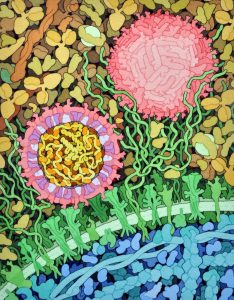Our Immunology and Infection Editor discusses the growing demand for more research to aid vaccine, and therapeutic development for the diagnosis, treatment, and mitigation of Zika related symptoms; highlighting two JoVE Video Articles with the similar research focus.
In the past two years, there has been an exponential increase in research on an arthropod-borne virus that has consumed the minds of people, scientists, researchers and media around the world. The Zika virus was first isolated in nonhuman primates and subsequently from mosquitoes in the 1940s. It has surfaced to be one of the deadliest villains in modern times. The most prevalent mode of transmission – mosquitoes, make an ideal host and the best route for infections. Additionally, it can also be transmitted through sexual contact, and an infected mother can also transmit the virus to her fetus.

Zika has been newsworthy for the past decade since the first outbreak was reported in the Western Pacific region. Additional outbreaks emerged from French Polynesia in the South Pacific, New Caledonia, Easter Island, Solomon Islands, etc. Soon a global Zika virus footprint was established, although most cases remained undetected. According to the Center for Disease Control, approximately 42,000 cases of Zika virus have been reported within the United States and US territories as of July 2017.
Unfortunately, the symptoms of Zika infections are nonspecific. The clinical presentation is a “dengue-like syndrome” which includes fever, myalgia, asthenia, rash, and conjunctivitis. Traditional laboratory serum tests for Zika virus are not entirely accurate due to the cross reactivity with other Flaviviruses antibodies. Molecular tests such as real time reverse transcription-PCR (ZIKV RT-PCR) are more promising and can detect the Zika virus RNA early during illness. Nevertheless, there’s a growing demand for more research to aid vaccine and therapeutic development for the diagnosis, treatment, and mitigation of Zika related symptoms.

In a recent JoVE article, Weger-Lucarelli, J, et al., described the construction of an infectious clone of Zika virus (ZIKV). The authors grew infectious clone plasmids and generated full-length viral RNA in vitro. A rolling circle amplification (RCA) which is a bacteria-free amplification technique was used to propagate plasmids. Following ligation, in vitro transcription and electroporation, the authors obtained a virus that showed similar in vitro growth kinetics and in vivo virulence in mice and mosquitoes, respectively.

As the Zika virus has also been known to transmit from mother-to-fetus during pregnancy, this virus can cause microcephaly, a congenital disability in which a baby’s head is smaller than expected. A group from the Novartis Institutes for BioMedical Research recently published a technique in JoVE wherein they modeled Zika virus infection in the developing human brain. As mentioned by Salick, M. R et al. (in press), the transmission of Zika from mother-to-fetus is due to the viral tropism of ZIKV, which is believed to target the neural progenitor cells (NPCs) of the developing brain. The authors use stem cell-derived cerebral organoids to understand more about ZIKV infection. In this unique paper, the authors prepare the organoids that have high levels of Zika virus that gradually causes microcephaly and cell death enabling us to understand the mechanisms of this infection during brain development.
It’s safe to say that we have become much more conscious of Zika in the past decade. This awareness has brought about an exponential increase in research around the world to develop a better diagnosis and come up with possible vaccines or treatments to prevent Zika. In the meantime, protection against mosquito bites is the most effective way to prevent a Zika infection.



